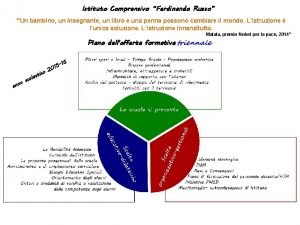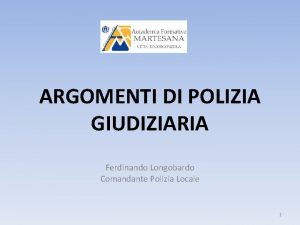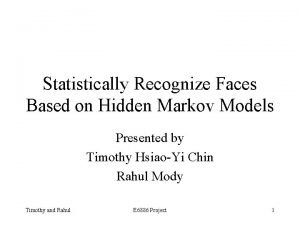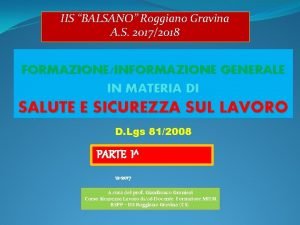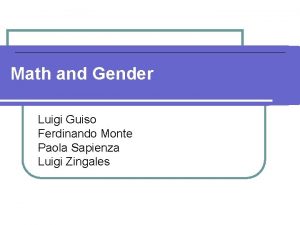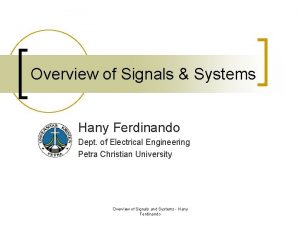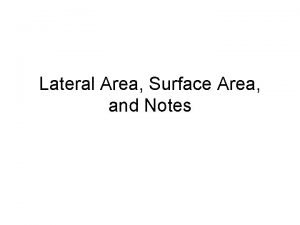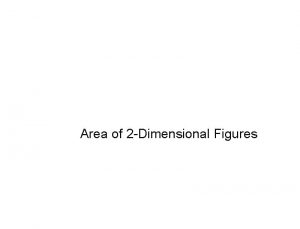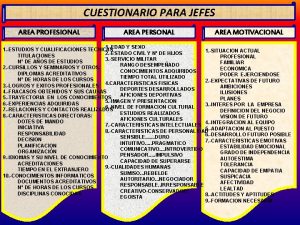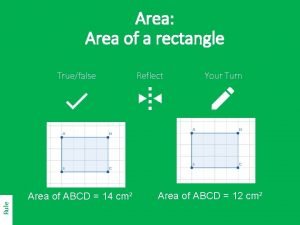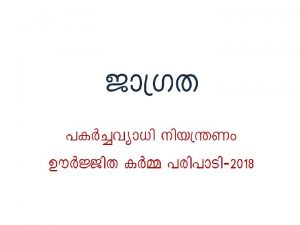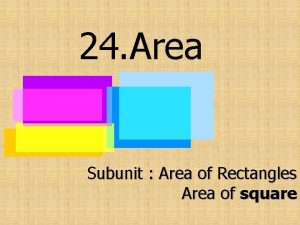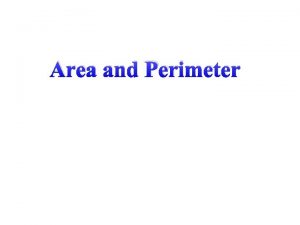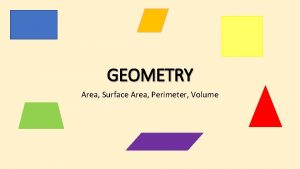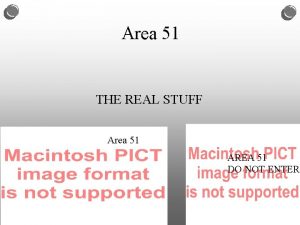EHDI SYSTEMS IN THE EUROPEAN AREA Ferdinando Grandori
































- Slides: 32

EHDI SYSTEMS IN THE EUROPEAN AREA Ferdinando Grandori European Project AHEAD II Quality of Life Programme – European Commission ferdinando. grandori@polimi. it

EHDI SYSTEMS IN THE EUROPEAN AREA • EHDI programs are becoming a major focus in the health care systems of the vast majority of the 15 countries of the European Union (EU) and in the European area at large • Slowly but steadily EHDI systems are being implemented in an increasing number of European countries

Europe – Milestones • 1993 NIH Consensus Statement • EC-Biomedical & Health Program - Project on • • • Otoacoustic Emissions (CA-OAE) 1993 -95 1995 World Health Organisation EC-Biomedical & Health Program - Project AHEAD 1996 -99 1998 European Consensus Development Conference 1999 AAP Statement NHS 2000 Conference (October 12 -14, 2000)

EHDI SYSTEMS IN THE EU Universal Newborn Hearing Screening is rapidly becoming a standard of care …. . THOUGH assessment and early intervention are still far from being well established 1+3+6 10

EHDI SYSTEMS IN THE EUROPEAN AREA • Methods of universal screening vary from hospital to hospital, for technology (TEOAE, DPOAE, ABR), for criteria and quality standards. • Nearly all recent UNHS programs makes use of AOAEs

OAE-based screening protocol(s) (well-babies) First OAE test pass STOP fail Second OAE test pass STOP fail ABR test pass STOP fail REFER

Screening protocols for at-risk babies • Several hospitals are using different protocols for well-babies and for babies at-risk • ABR is used, alone or in combination with OAEs (still risk categories survive…. )

EHDI SYSTEMS IN THE EUROPEAN AREA • The penetration of newborn screening differs greatly from country to country, and within the same country, from area to area • About 10% of the newborns in the EU are currently (Feb 2002) screened for hearing

EHDI SYSTEMS IN THE EUROPEAN AREA • A bottom-up approach was followed in the largest majority of the European countries • Universal hearing screening is mandated - or supported - by the central health authorities, in a number countries, or regions: Austria, Belgium (Flanders), Croatia, Czech Rep. , Holland, Hungary, Lithuania, Luxembourg, Netherlands, 3 Laenders in Germany, several “Regions” of Italy (7 out of 20), 5 “Commmunities” of Spain • In the UK (England) legislation is expected soon (200+ hospitals are just starting)

EHDI SYSTEMS IN THE EUROPEAN AREA • Ambitious programs have been implemented in nearly all the other countries of the EU • However, some countries are still well behind such as France, Greece (public hospitals), Norway, Portugal • In many countries of central and eastern Europe several EHDI programs already exist (Latvia, Romania, Russia, Slovenia)

EHDI SYSTEMS IN THE EUROPEAN AREA • Infants hearing screening programs have been in place for many (15+) years (Denmark, Germany, Hollands, Italy, Sweden, UK) with poor results. • It is often more difficult to change mentality/procedures than establish new models…. .

It is often more difficult to change mentality/procedures than establish new models …… • This is very clearly shown by the paradigmatic examples of the Scandinavian/Nordic countries, on the one hand…. . • and on the other hand by central and eastern European countries that have entirely re-designed their health care systems during the past 5 to 10 years.

Poland (population: 30 mln – annual births: 380, 000) • After about one year of planning, a non-profit Foundation “The Great Orchestra of Christmas Charity” has funded the start of EHDI programs • Dr. Jerzy Puzio, Dr. Marzanna Radziszewska, The Children’s Memorial Health Institute, Warsaw, Poland 440 maternity departments 46 second level audiological centers 7 audiological centers for intervention ALL OUR BEST WISHES OF A SUCCESSFUL START

EHDI SYSTEMS IN THE EUROPEAN AREA Poland 400+ maternity departments 45+ second level audiological centers 7 audiological centers for intervention OUR BEST WISHES!


EHDI SYSTEMS IN THE EUROPEAN AREA England The National Screening Committee Trial 20 Sites, or Health Districts, incorporating 30+ hospitals The conception was a rather long lasting process, but a national EHDI system is under way now

QUALITY STANDARDS OF SCREENING PROTOCOLS • Quality standards are still lacking for the various screening protocols. • Only very few screening devices have been clinically validated in large scale trials aimed at evaluating the performances of the new automatic algorithms.

FUTURE RESEARCH • optimize screening technologies • screening criteria for well- and at-risk babies • strategies/technologies for early assessment (particularly methods for diagnostic ABR) • strategies for early fitting • criteria for implantation in very young infants (how young? bilateral? Brainstem? )

FUTURE OF EHDI SYSTEMS IN THE EU • • Successful implementation of EHDI systems will crucially depend on availability of a new generation of professionals This is not surprising because EHDI systems were an undemanded need (Adrian Davis)

Euro-survey: AHEAD II By Steering group F. Grandori (project leader) L. Collet (France) M. Moro (Spain) A. Parving (Denmark) K. Schorn (Germany) I. Uloziene (Lithuania) K. Welzl-Müller (Austria) LAST UPDATE: Nov. 2001

Objectives - to achieve information on: • Age at identification of HI – children • Assessment - methods • Protocols for etiological evaluation • National recommendations/guidelines on surveillance programmes • Links to educational system • Employment of hearing therapists in EHDI • Employment of physicians/audiologists in the educational system

Procedure: • 221 questionaires mailed to delegates attending NHS-2000 – Milan and to those in our mailing lists • N = 56 responses returned to A. Parving • Descriptive analysis

Responses: N=56~27 countries COUNTRY N Israel 3 Austria 1 Italy 5 Belgium 2 Lithuania 1 Croatia 1 Luxemburg 1 Czech Rep. 5 Norway 2 Denmark 2 Poland 1 England 1 Romania 1 Finland 1 Slovakia 1 France 3 Slovenia 1 Germany 1 Spain 5 Greece 2 Sweden 1 Holland 3 Switzerland 2 Hungary 1 Turkey 1 Ireland 2 Wales 1

Methods for assesment of hearing level/threshold Perform: N=51 BOA 24 VRA 25 Peep show 11 Play aud. 35 ECo. G 7 ABR 44 OAE 36

Time lapse from assesment to HA-fitting N % 1 mths 12 23. 5 2 mths 16 31. 4 3 mths 11 21. 6 Missing data: N=12~23. 5% (poor communication)

Screening infancy/childhood YES NO nr Screening < 12 months 44 (86. 2%) 4 (7. 8%) 3 (5. 8%) Screening at 1 -4 years 25 (49. 0%) 10 (19. 6%) 16 (31. 3%) School entrance 31 (60. 8%) 8 (15. 6%) 12 (23. 5%) Screening later 19 (37. 2%) 11 (21. 5%) 21 (41. 1%)

Habilitation before fitting Reporting N Yes 18 (35. 2%) No 19 (37. 2%) No Resp. 14 (27. 4%)

Protocol for aetiological evaluation Using protocol: N=31/51 (N=21 missing) N Do imaging of inner ear 31 Do opthalmological exam. 30 Do genotypes (predominantly connexin 26) Do electrocardiogram 26 21

Services (1) • Guidelines for national surveillance programmes: N=13/48 (27. 1%) (N=8 miss. ) • Guidelines for regional surveillance programmes: N=23/47 (48. 9%) (N=9 miss. )

Services (2) • Links to educational system: • Reporting yes: N= 38/47 (80%) (N=9 miss. ) • N=29/38 (76. 3%) Have hearing therapists ”employed ” in EHDI • N=16 (42. 1%) Have physicians/ audiologists ”employed” in educational systems

2 nd INTERNATIONAL CONFERENCE ON NEWBORN HEARING SCREENING DIAGNOSIS AND INTERVENTION Como Lake, Italy, May 30 – June 1 st, 2002 Organisers: Ferdi Grandori & Deborah Hayes www. biomed. polimi. it/NHS 2002

nhs 2002@polimi. it TOPICS Newborn hearing screening Audiological assessment of infants Medical and surgical intervention for hearing loss Genetics of hearing loss Strategies for aural habilitation Hearing aids and cochlear implants Psychophysical measures of auditory function Physiologic measures of audiological function Language development, cognition and deafness Neuromaturation Auditory neuropathies Perspectives of the Deaf community
 Monje ferdinando facchinei
Monje ferdinando facchinei Istituto ferdinando russo
Istituto ferdinando russo Ferdinando longobardo
Ferdinando longobardo Ferdinando samaria
Ferdinando samaria Iis roggiano gravina
Iis roggiano gravina Ferdinando monte
Ferdinando monte Hát kết hợp bộ gõ cơ thể
Hát kết hợp bộ gõ cơ thể Bổ thể
Bổ thể Tỉ lệ cơ thể trẻ em
Tỉ lệ cơ thể trẻ em Voi kéo gỗ như thế nào
Voi kéo gỗ như thế nào Glasgow thang điểm
Glasgow thang điểm Bài hát chúa yêu trần thế alleluia
Bài hát chúa yêu trần thế alleluia Môn thể thao bắt đầu bằng từ đua
Môn thể thao bắt đầu bằng từ đua Thế nào là hệ số cao nhất
Thế nào là hệ số cao nhất Các châu lục và đại dương trên thế giới
Các châu lục và đại dương trên thế giới Công thức tính độ biến thiên đông lượng
Công thức tính độ biến thiên đông lượng Trời xanh đây là của chúng ta thể thơ
Trời xanh đây là của chúng ta thể thơ Mật thư tọa độ 5x5
Mật thư tọa độ 5x5 Làm thế nào để 102-1=99
Làm thế nào để 102-1=99 Phản ứng thế ankan
Phản ứng thế ankan Các châu lục và đại dương trên thế giới
Các châu lục và đại dương trên thế giới Thể thơ truyền thống
Thể thơ truyền thống Quá trình desamine hóa có thể tạo ra
Quá trình desamine hóa có thể tạo ra Một số thể thơ truyền thống
Một số thể thơ truyền thống Cái miệng nó xinh thế chỉ nói điều hay thôi
Cái miệng nó xinh thế chỉ nói điều hay thôi Vẽ hình chiếu vuông góc của vật thể sau
Vẽ hình chiếu vuông góc của vật thể sau Biện pháp chống mỏi cơ
Biện pháp chống mỏi cơ đặc điểm cơ thể của người tối cổ
đặc điểm cơ thể của người tối cổ Thế nào là giọng cùng tên? *
Thế nào là giọng cùng tên? * Vẽ hình chiếu đứng bằng cạnh của vật thể
Vẽ hình chiếu đứng bằng cạnh của vật thể Vẽ hình chiếu vuông góc của vật thể sau
Vẽ hình chiếu vuông góc của vật thể sau Thẻ vin
Thẻ vin

